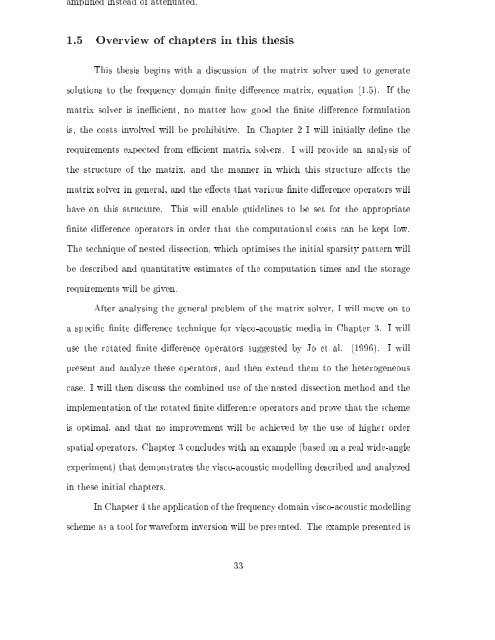Frequency domain seismic forward modelling: A tool for waveform ...
Frequency domain seismic forward modelling: A tool for waveform ...
Frequency domain seismic forward modelling: A tool for waveform ...
You also want an ePaper? Increase the reach of your titles
YUMPU automatically turns print PDFs into web optimized ePapers that Google loves.
amplied instead of attenuated.<br />
1.5 Overview of chapters in this thesis<br />
This thesis begins with a discussion of the matrix solver used to generate<br />
solutions to the frequency <strong>domain</strong> nite dierence matrix, equation (1.5). If the<br />
matrix solver is inecient, no matter how good the nite dierence <strong>for</strong>mulation<br />
is, the costs involved will be prohibitive.<br />
In Chapter 2 I will initially dene the<br />
requirements expected from ecient matrix solvers. I will provide an analysis of<br />
the structure of the matrix, and the manner in which this structure aects the<br />
matrix solver in general, and the eects that various nite dierence operators will<br />
have on this structure.<br />
This will enable guidelines to be set <strong>for</strong> the appropriate<br />
nite dierence operators in order that the computational costs can be kept low.<br />
The technique of nested dissection, which optimises the initial sparsity pattern will<br />
be described and quantitative estimates of the computation times and the storage<br />
requirements will be given.<br />
After analysing the general problem of the matrix solver, I will move on to<br />
a specic nite dierence technique <strong>for</strong> visco-acoustic media in Chapter 3. I will<br />
use the rotated nite dierence operators suggested by Jo et al. (1996). I will<br />
present and analyze these operators, and then extend them to the heterogeneous<br />
case. I will then discuss the combined use of the nested dissection method and the<br />
implementation of the rotated nite dierence operators and prove that the scheme<br />
is optimal, and that no improvement will be achieved by the use of higher order<br />
spatial operators. Chapter 3 concludes with an example (based on a real wide-angle<br />
experiment) that demonstrates the visco-acoustic <strong>modelling</strong> described and analyzed<br />
in these initial chapters.<br />
In Chapter 4 the application of the frequency <strong>domain</strong> visco-acoustic <strong>modelling</strong><br />
scheme as a <strong>tool</strong> <strong>for</strong> wave<strong>for</strong>m inversion will be presented. The example presented is<br />
33

















